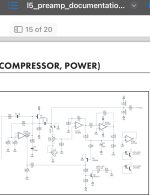So I got caught up in the Aoin fx sale frenzy and ordered the L5 pre Board. I had been looking at it for a while, but never pulled the trigger because of the lack of a balanced out. Well that and the $16 converter, but why let a little thing like money get in the way…. I know I had asked before ab making my own direct box and was pointed in the direction of one of the THAT chips, but then I got to thinking, the MBP Sludgehammer has balanced out w/o the use of the fancy chip so my ask is, can this block:

Starting with R33 (or should it be everything after C26) just be tacked on to this:
If it’s that simple, would it go after R81? Thoughts, pshhaws, or you’re just fucking nuts to be had here?

Starting with R33 (or should it be everything after C26) just be tacked on to this:

If it’s that simple, would it go after R81? Thoughts, pshhaws, or you’re just fucking nuts to be had here?


